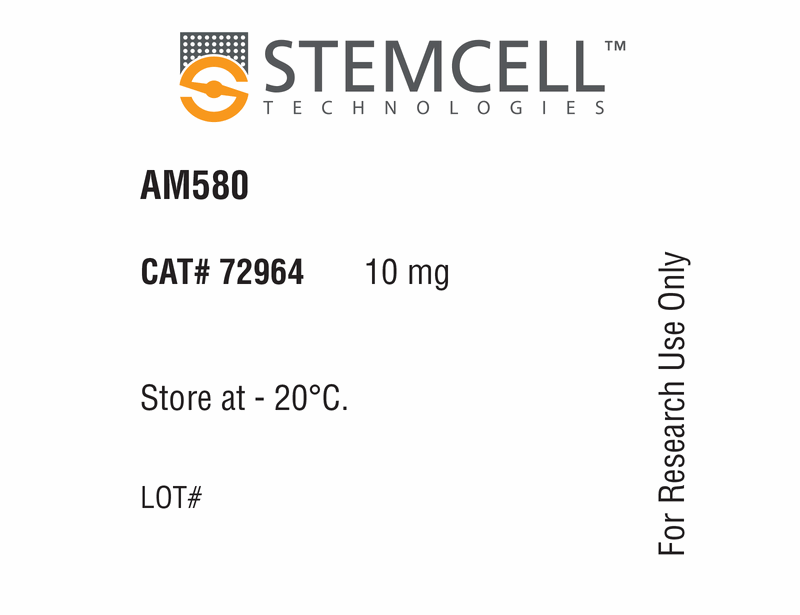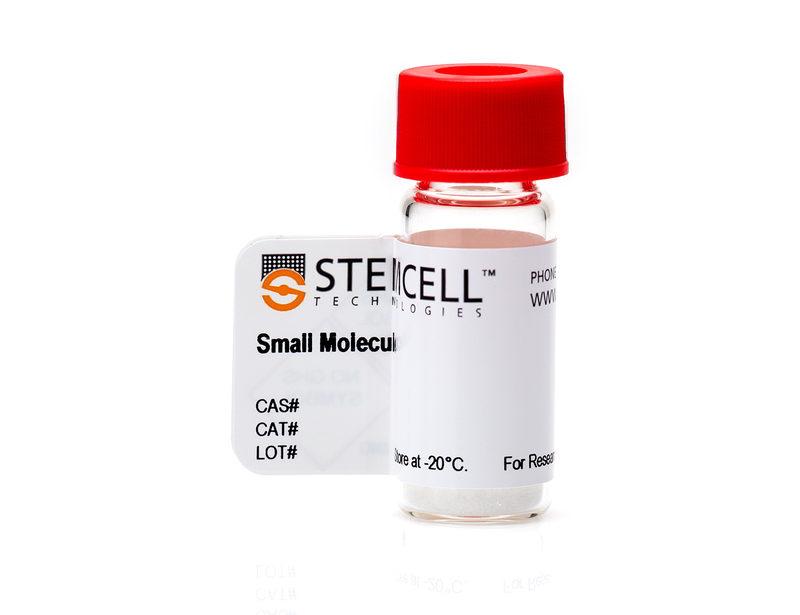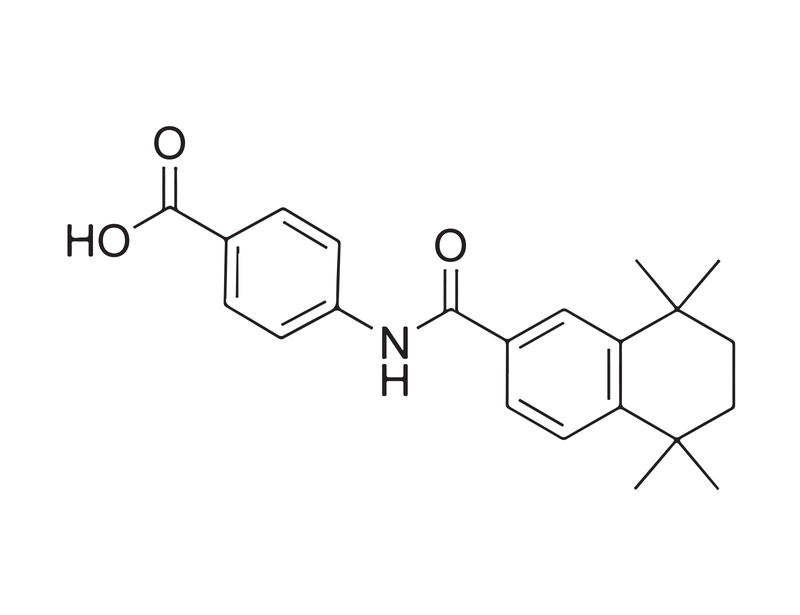概要
AM580 is a retinoic acid receptor (RAR) agonist that is selective for RARα (EC₅₀ = 0.36 nM) compared to RARβ (EC₅₀ = 24.6 nM) and RARγ (EC₅₀ = 27.9 nM; Bernard et al.) It is a derivative of retinoic acid (RA), however it demonstrates greater specific binding to RARα compared to RA, which exhibits little selectivity across RARα, β, or γ (Gianní et al.; Bernard et al.; Kim et al; Rochette-Egly & Germain).
REPROGRAMMING
· Promotes reprogramming of somatic cells to induced pluripotent stem cells (Wang et al.).
DIFFERENTIATION
· Induces differentiation of human induced pluripotent stem cells into intermediate mesoderm, in combination with the GSK3β inhibitor CHIR99021 (Araoka et al.).
CANCER RESEARCH
· Inhibits tumor cell proliferation and survival signaling pathways, and induces apoptosis, leading to inhibition of mouse mammary tumor virus (MMTV)-neu- and MMTV-wnt1-induced mammary gland hyperplasia (Lu et al.).
· Inhibits tumor growth in MMTV-Myc mice (Bosch et al.).
· Inhibits endometrial cancer cell proliferation (Cheng et al.).
· Induces differentiation in acute promyelocytic leukemia cells (Gianní et al.).
REPROGRAMMING
· Promotes reprogramming of somatic cells to induced pluripotent stem cells (Wang et al.).
DIFFERENTIATION
· Induces differentiation of human induced pluripotent stem cells into intermediate mesoderm, in combination with the GSK3β inhibitor CHIR99021 (Araoka et al.).
CANCER RESEARCH
· Inhibits tumor cell proliferation and survival signaling pathways, and induces apoptosis, leading to inhibition of mouse mammary tumor virus (MMTV)-neu- and MMTV-wnt1-induced mammary gland hyperplasia (Lu et al.).
· Inhibits tumor growth in MMTV-Myc mice (Bosch et al.).
· Inhibits endometrial cancer cell proliferation (Cheng et al.).
· Induces differentiation in acute promyelocytic leukemia cells (Gianní et al.).
技术资料
| Document Type | 产品名称 | Catalog # | Lot # | 语言 |
|---|---|---|---|---|
| Product Information Sheet | AM580 | 72962, 72964 | All | English |
| Safety Data Sheet | AM580 | 72962, 72964 | All | English |
数据及文献
Publications (9)
PloS one 2014 JAN
Efficient and rapid induction of human iPSCs/ESCs into nephrogenic intermediate mesoderm using small molecule-based differentiation methods.
Abstract
Abstract
The first step in developing regenerative medicine approaches to treat renal diseases using pluripotent stem cells must be the generation of intermediate mesoderm (IM), an embryonic germ layer that gives rise to kidneys. In order to achieve this goal, establishing an efficient, stable and low-cost method for differentiating IM cells using small molecules is required. In this study, we identified two retinoids, AM580 and TTNPB, as potent IM inducers by high-throughput chemical screening, and established rapid (five days) and efficient (80% induction rate) IM differentiation from human iPSCs using only two small molecules: a Wnt pathway activator, CHIR99021, combined with either AM580 or TTNPB. The resulting human IM cells showed the ability to differentiate into multiple cell types that constitute adult kidneys, and to form renal tubule-like structures. These small molecule differentiation methods can bypass the mesendoderm step, directly inducing IM cells by activating Wnt, retinoic acid (RA), and bone morphogenetic protein (BMP) pathways. Such methods are powerful tools for studying kidney development and may potentially provide cell sources to generate renal lineage cells for regenerative therapy.
Breast Cancer Research 2012
Reversal by RARα agonist Am580 of c-Myc-induced imbalance in RARα/RARγ expression during MMTV-Myc tumorigenesis
Abstract
Abstract
INTRODUCTION: Retinoic acid signaling plays key roles in embryonic development and in maintaining the differentiated status of adult tissues. Recently, the nuclear retinoic acid receptor (RAR) isotypes α, β and γ were found to play specific functions in the expansion and differentiation of the stem compartments of various tissues. For instance, RARγ appears to be involved in stem cell compartment expansion, while RARα and RARβ are implicated in the subsequent cell differentiation. We found that over-expressing c-Myc in normal mouse mammary epithelium and in a c-Myc-driven transgenic model of mammary cancer, disrupts the balance between RARγ and RARα/β in favor of RARγ. METHODS: The effects of c-Myc on RAR isotype expression were evaluated in normal mouse mammary epithelium, mammary tumor cells obtained from the MMTV-Myc transgenic mouse model as well as human normal immortalized breast epithelial and breast cancer cell lines. The in vivo effect of the RARα-selective agonist 4-[(5,6,7,8-tetrahydro-5,5,8,8-tetramethyl-2-naphthyl)carboxamido]benzoic acid (Am580) was examined in the MMTV-Myc mouse model of mammary tumorigenesis. RESULTS: Modulation of the RARα/β to RARγ expression in mammary glands of normal mice, oncomice, and human mammary cell lines through the alteration of RAR-target gene expression affected cell proliferation, survival and tumor growth. Treatment of MMTV-Myc mice with the RARα-selective agonist Am580 led to significant inhibition of mammary tumor growth (˜90%, Ptextless0.001), lung metastasis (Ptextless0.01) and extended tumor latency in 63% of mice. Immunocytochemical analysis showed that in these mice, RARα responsive genes such as Cyp26A1, E-cadherin, cellular retinol-binding protein 1 (CRBP1) and p27, were up-regulated. In contrast, the mammary gland tumors of mice that responded poorly to Am580 treatment (37%) expressed significantly higher levels of RARγ. In vitro experiments indicated that the rise in RARγ was functionally linked to promotion of tumor growth and inhibition of differentiation. Thus, activation of the RARα pathway is linked to tumor growth inhibition, differentiation and cell death. CONCLUSIONS: The functional consequence of the interplay between c-Myc oncogene expression and the RARγ to RARα/β balance suggests that prevalence of RARγ over-RARα/β expression levels in breast cancer accompanied by c-Myc amplification or over-expression in breast cancer should be predictive of response to treatment with RARα-isotype-specific agonists and warrant monitoring during clinical trials.
Proceedings of the National Academy of Sciences of the United States of America 2011 NOV
Rapid and efficient reprogramming of somatic cells to induced pluripotent stem cells by retinoic acid receptor gamma and liver receptor homolog 1.
Abstract
Abstract
Somatic cells can be reprogrammed to induced pluripotent stem cells (iPSCs) by expressing four transcription factors: Oct4, Sox2, Klf4, and c-Myc. Here we report that enhancing RA signaling by expressing RA receptors (RARs) or by RA agonists profoundly promoted reprogramming, but inhibiting it using a RAR-α dominant-negative form completely blocked it. Coexpressing Rarg (RAR-γ) and Lrh-1 (liver receptor homologue 1; Nr5a2) with the four factors greatly accelerated reprogramming so that reprogramming of mouse embryonic fibroblast cells to ground-state iPSCs requires only 4 d induction of these six factors. The six-factor combination readily reprogrammed primary human neonatal and adult fibroblast cells to exogenous factor-independent iPSCs, which resembled ground-state mouse ES cells in growth properties, gene expression, and signaling dependency. Our findings demonstrate that signaling through RARs has critical roles in molecular reprogramming and that the synergistic interaction between Rarg and Lrh1 directs reprogramming toward ground-state pluripotency. The human iPSCs described here should facilitate functional analysis of the human genome.
Journal of molecular endocrinology 2011
Retinoic acid inhibits endometrial cancer cell growth via multiple genomic mechanisms.
Abstract
Abstract
Previous studies have indicated that retinoic acid (RA) may be therapeutic for endometrial cancer. However, the downstream target genes and pathways triggered by ligand-activated RA receptor α (RARα) in endometrial cancer cells are largely unknown. In this study, 3-(4,5-dimethylthiazol-2-yl)-2,5-diphenyltetrazolium bromide, flow cytometry, and immunoblotting assays were used to assess the roles of RA and the RA agonist (AM580) in the growth of endometrial cancer cells. Illumina-based microarray expression profiling of endometrial Ishikawa cells incubated with and without AM580 for 1, 3, and 6 h was performed. We found that both RA and AM580 markedly inhibited endometrial cancer cell proliferation, while knockdown of RARα could block AM580 inhibition. Knockdown of RARα significantly increased proliferating cell nuclear antigen and BCL2 protein levels. Incubation of Ishikawa cells with or without AM580 followed by microarray expression profiling showed that 12 768 genes out of 47 296 gene probes were differentially expressed with significant P values. We found that 90 genes were the most regulated genes with the most significant P value (Ptextless0.0001) using F-test. We selected four highly regulated genes with diverse functions, namely G0S2, TNFAIP2, SMAD3, and NRIP1. Real-time PCR verified that AM580 highly regulated these genes, whereas chromatin immunoprecipitation-PCR assay demonstrated that ligand-activated RARα interacted with the promoter of these genes in intact endometrial cancer cells. AM580 also significantly altered 18 pathways including those related to cell growth, differentiation, and apoptosis. In conclusion, AM580 treatment of Ishikawa cells causes the differential expression of a number of RARα target genes and activation of signaling pathways. These pathways could, therefore, mediate the carcinogenesis of human endometrial cancer.
Oncogene 2010
Mechanism of inhibition of MMTV-neu and MMTV-wnt1 induced mammary oncogenesis by RARalpha agonist AM580.
Abstract
Abstract
We hypothesized that specific activation of a single retinoic acid receptor-alpha (RARalpha), without direct and concurrent activation of RARbeta and gamma, will inhibit mammary tumor oncogenesis in murine models relevant to human cancer. A total of 50 uniparous mouse mammary tumor virus (MMTV)-neu and 50 nuliparous MMTV-wnt1 transgenic mice were treated with RARalpha agonist (retinobenzoic acid, Am580) that was added to the diet for 40 (neu) and 35 weeks (wnt1), respectively. Among the shared antitumor effects was the inhibition of epithelial hyperplasia, a significant increase (Ptextless0.05) in tumor-free survival and a reduction in tumor incidence and in the growth of established tumors. In both models, the mechanisms responsible for these effects involved inhibition of proliferation and survival pathways, and induction of apoptosis. The treatment was more effective in the MMTV-wnt1 model in which Am580 also induced differentiation, in both in vivo and three-dimensional (3D) cultures. In these tumors Am580 inhibited the wnt pathway, measured by loss of nuclear beta-catenin, suggesting partial oncogene dependence of therapy. Am580 treatment increased RARbeta and lowered the level of RARgamma, an isotype whose expression we linked with tumor proliferation. The anticancer effect of RARalpha, together with the newly discovered pro-proliferative role of RARgamma, suggests that specific activation of RARalpha and inhibition of RARgamma might be effective in breast cancer therapy.
Nuclear receptor signaling 2009
Dynamic and combinatorial control of gene expression by nuclear retinoic acid receptors (RARs).
Abstract
Abstract
Nuclear retinoic acid receptors (RARs) are transcriptional regulators controlling the expression of specific subsets of genes in a ligand-dependent manner. The basic mechanism for switching on transcription of cognate target genes involves RAR binding at specific response elements and a network of interactions with coregulatory protein complexes, the assembly of which is directed by the C-terminal ligand-binding domain of RARs. In addition to this scenario, new roles for the N-terminal domain and the ubiquitin-proteasome system recently emerged. Moreover, the functions of RARs are not limited to the regulation of cognate target genes, as they can transrepress other gene pathways. Finally, RARs are also involved in nongenomic biological activities such as the activation of translation and of kinase cascades. Here we will review these mechanisms, focusing on how kinase signaling and the proteasome pathway cooperate to influence the dynamics of RAR transcriptional activity.

 网站首页
网站首页





